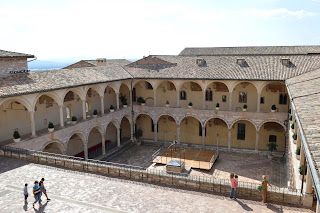 There are two parts to this town. The older Roman and medieval town on the hill and the newer but with old monuments beneath the hill. The Basilica of St Francis (San Francesco) is in the town on the bottom, the Basilica of St Clare is up the hill. Transport is best between the two. A very nice lunch is available at a restaurant surrounded by green space in the lower part of the town. In fact, it was the only one worth eating at in the entire trip.
There are two parts to this town. The older Roman and medieval town on the hill and the newer but with old monuments beneath the hill. The Basilica of St Francis (San Francesco) is in the town on the bottom, the Basilica of St Clare is up the hill. Transport is best between the two. A very nice lunch is available at a restaurant surrounded by green space in the lower part of the town. In fact, it was the only one worth eating at in the entire trip. The most important event in the history of medieval Assisi was
undoubtedly the life and work of Francis of Assisi (1182-1226), who
initiated the Franciscan Order and who was canonised in 1228. His
companion, Clare, also later canonised, founded the sister order to the
Franciscans. After the canonisation of St Francis, it was decided to
build a monumental church in his honour. This construction was followed
by the Basilica of Santa Chiara to honour St Clare.
The most important event in the history of medieval Assisi was
undoubtedly the life and work of Francis of Assisi (1182-1226), who
initiated the Franciscan Order and who was canonised in 1228. His
companion, Clare, also later canonised, founded the sister order to the
Franciscans. After the canonisation of St Francis, it was decided to
build a monumental church in his honour. This construction was followed
by the Basilica of Santa Chiara to honour St Clare.
The construction of the Basilica of San Francesco was started in 1228. The lower basilica is entered through an exquisite Gothic portal; the interior is completely covered with frescoes. The earliest of these date from 1253 and are by an unknown artist, the Maestro di San Francesco.

Furthermore, the paintings include allegories attributed to Giotto and his school in the presbytery, the Virgin with a Child on the Throne by Cimabue, and the Crucifixion by Giotto, the paintings by Pietro Lorenzetti and his assistants, and the Chapel of St-Martin by Simone Martini.
 The upper basilica has a
magnificent east front in white limestone, with a large rose window in
the centre. In the interior, the walls are decorated with series of
paintings relating to the faith and life of the saint.
The upper basilica has a
magnificent east front in white limestone, with a large rose window in
the centre. In the interior, the walls are decorated with series of
paintings relating to the faith and life of the saint.The Basilica of San Francesco d'Assisi (St. Francis), a Franciscan monastery,and the lower and upper church (Italian: Basilica inferiore and Basilica superiore) of St Francis were begun immediately after his canonisation in 1228, and completed in 1253. The lower church has frescoes by the late-medieval artists Cimabue and Giotto; the upper church houses frescoes of scenes in the life of St. Francis previously ascribed to Giotto, but now thought to be by artists of the circle of Pietro Cavallini from Rome. The Basilica was badly damaged by an earthquake on 26 September 1997, during which part of the vault collapsed, killing four people inside the church and carrying with it a fresco by Cimabue. The edifice was closed for two years for restoration
 The Santa Chiara Basilica (St. Clare) with its massive lateral buttresses, rose window, and simple gothic interior, begun in 1257, contains the tomb of St Clare (clearly on display with a manequin on top to look like her) and 13th‑century frescoes and paintings.
The Santa Chiara Basilica (St. Clare) with its massive lateral buttresses, rose window, and simple gothic interior, begun in 1257, contains the tomb of St Clare (clearly on display with a manequin on top to look like her) and 13th‑century frescoes and paintings. If you want a souvenir you'll find lots of cheap religious stuff, including little statues of St Francis for sale in the stalls in both the upper and lower town.
If you want a souvenir you'll find lots of cheap religious stuff, including little statues of St Francis for sale in the stalls in both the upper and lower town.
What I enjoyed: Lunch of two pasta courses, a meat course and a dessert; seeing the little church where St Francis started off (like a doll's house since he only had a handful of followers. It's inside the main church. The upper town itself is quaint and pleasant to walk through (steep in places though).

What I didn't like: being shown relics of St Clare reported to be her habit/clothing etc in the murky light. Oh yeah, I was so convinced they were genuine 600 year old sackcloth clothes still in excellent state with the fold marks (was that from ironing?) still very obvious. NOT. This whole scam of relics makes my blood boil. Yet another dishonest many-making venture of the church? I guess you have to make up your own mind on that.















0 comments:
Post a Comment
I welcome your comments, contributions and feedback.